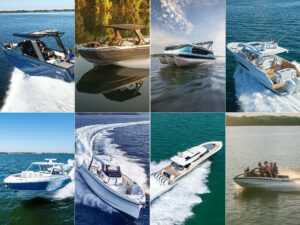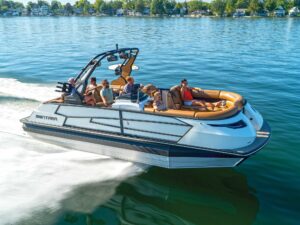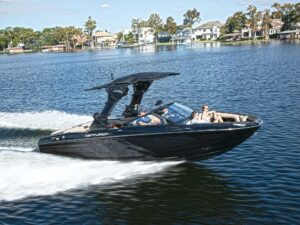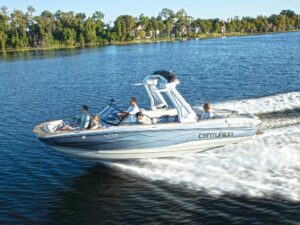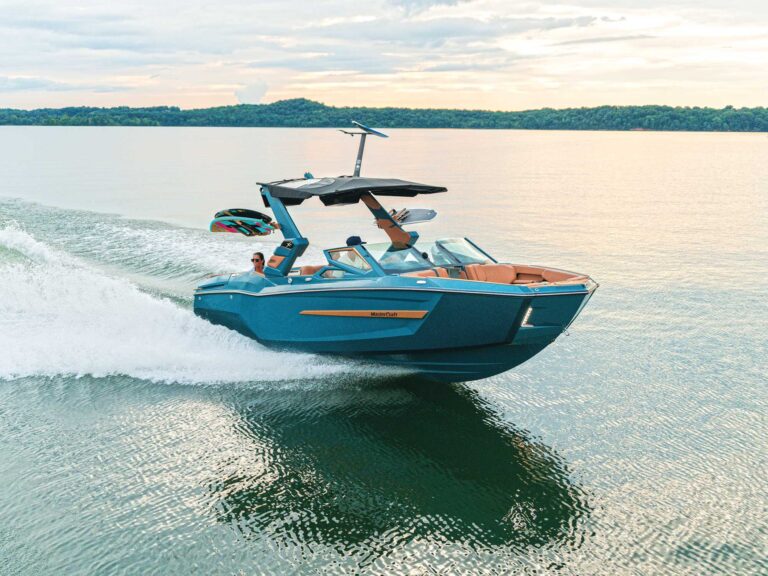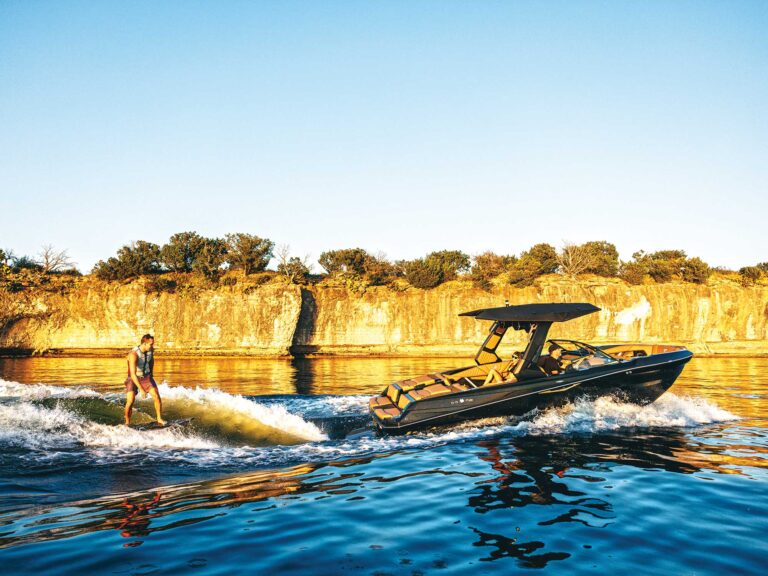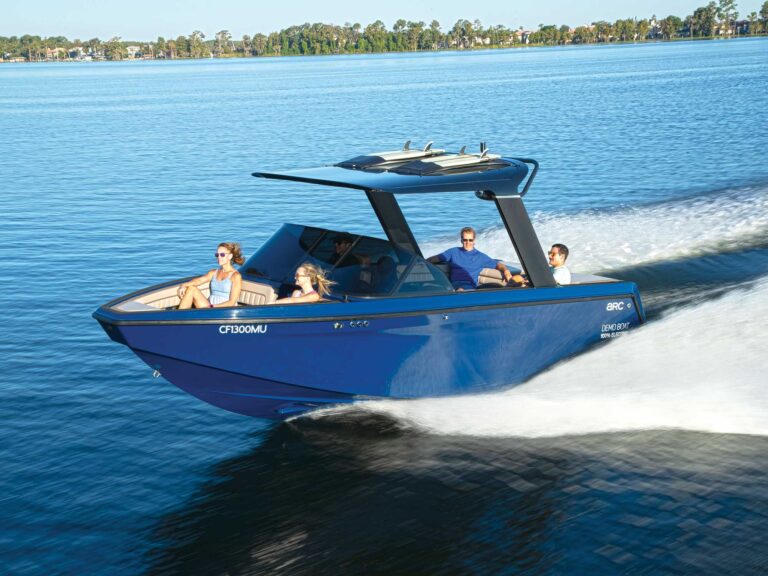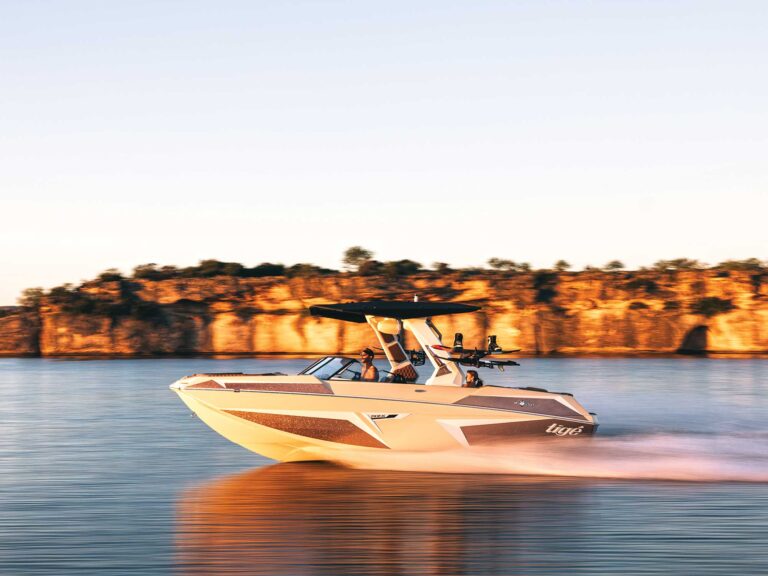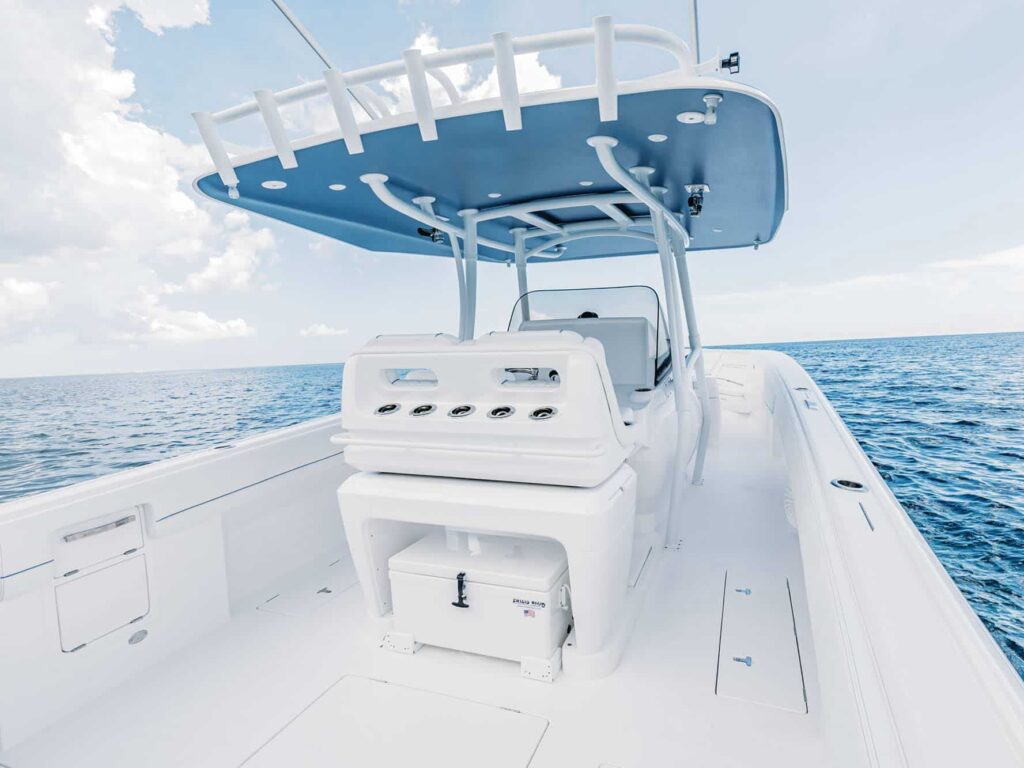
After 15 years, the non-slip paint on my boat deck looked faded and dirty. But I put off repainting until the non skid failed and I started slipping and sliding on the wet deck. While a freshly painted boat deck looks great, providing a non-slip surface is the first step in maintaining a safe boat.
There are several steps to repainting a boat deck. Taping off the area, cleaning the deck, sanding the old non skid paint, cleaning again, painting, drying, adding another coat of paint, drying and clean-up are all essential to getting the job done correctly.
But the most important step happened before I began the project. Choosing the best marine deck anti-skid paint for my boat deck is directly related to the quality of the final result. With so many choices for non skid paint to match my needs, I took a deep dive into the best boat deck paint for my boat. Here is what I learned.
Quicklook: 6 Top Boat Non Skid Deck Paint Options
- Best for Long-lasting Results: Pettit Paint EZ Deck
- Best for Impact Resistance: Pettit Paint Tuff Coat Rubberized
- Best Textured Non Skid Deck Paint: KiwiGrip Non-skid
- Best Two Part Deck Paint: Interlux Perfection Two Part
- Best Budget Deck Paint: Interlux Interdeck
- Best Aggregate: Alexseal Non Skid Fine HD
Best Non Skid Boat Deck Paint
Repainting the non-slip surfaces on the boat deck is a big job. Before picking an anti-skid paint, consider how often you use your boat, how much you have to spend, where you work on the boat and what equipment you have to get the job done.
For easy application, choose a one-part paint system, or to match the boat’s color and provide a more durable surface, go with a two-part paint and non skid additive. To make sense of the choices, I narrowed down my list to the following best non skid marine deck paints for my boat.

Pettit Paint EZ Deck
Best for: Long-lasting results
The simplest way to achieve a durable and good-looking non skid deck surface is using a one-part deck paint with aggregate. Pettit Paint EZ Deck is the top performing deck anti-skid paint for easy application and fade resistance. After the deck surface is prepared, simply stir the EZ Deck to distribute the aggregate and apply three to four coats with a ⅜ inch nap roller.
Features:
- One step process
- Ultraviolet filters prevent color fade
- Premixed aggregate
Disadvantages:
- Only available in three colors
- For best results, add EZPoxy Paint Enhancer
Price: $182.99/gallon

Pettit Paint Tuff Coat Rubberized
Best for: Impact resistance
For high-traffic areas and hard use, rubberized deck paint offers a thicker and more durable surface. Often found on commercial vessels, rubberized marine deck paints are flexible, thick and super grippy. Pettit Paint’s Tuff Coat Rubberized non skid deck paint is a one-step paint created by cross-linking urethanes, acrylics, co-polymers and recycled rubber granules to maximize durability and performance.
I like the rubber granules as the aggregate to maintain consistent texture and prevent wear and tear. The thick coat of rubber paint also provides shock absorption. Non-toxic and water based, Tuff Coat is easy to apply with a roller or brush and easy to clean up with soap and water.
Features:
- Thick material hides surface imperfections
- Submersible
- Shock absorbing rubber aggregate
Disadvantages:
- Aggressive grip not comfortable on bare feet
- Matte finish only
- Requires primer
Price: $154.99/gallon
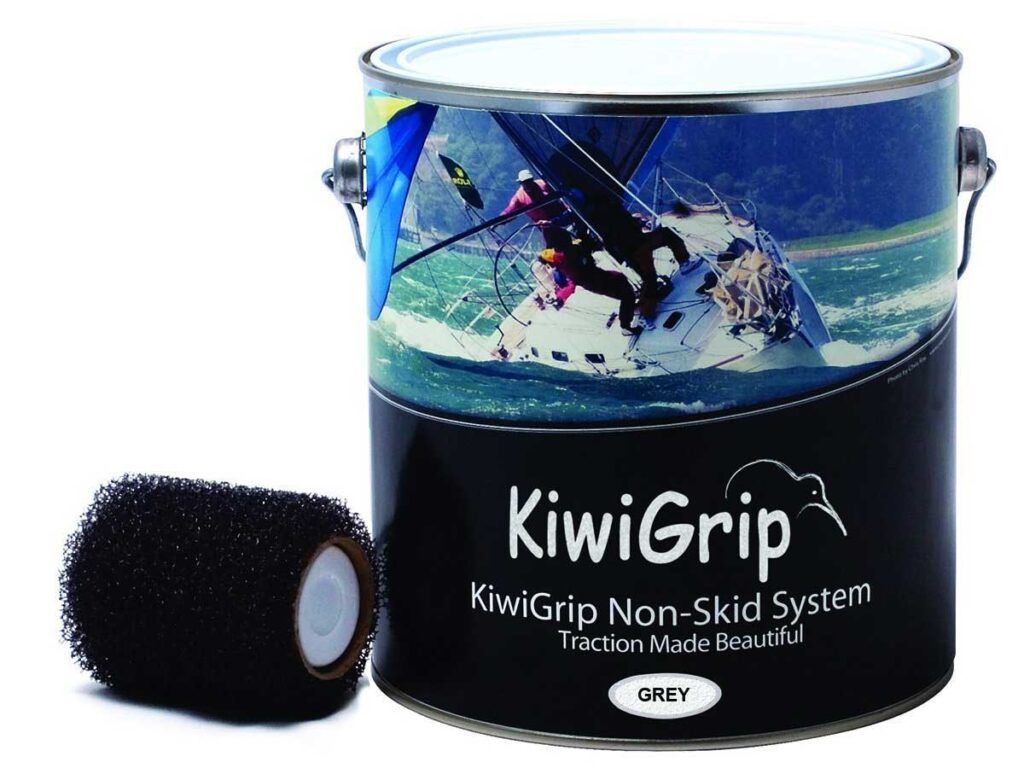
KiwiGrip Non-Skid System
Best for: Textured non skid deck paint
Most non-slip deck paint uses an abrasive additive to provide grip on slippery decks. Another option is using a thick deck paint and a special paint roller to dimple the paint for a non skid texture. KiwiGrip Non-Skid System doesn’t require mixing the aggregate with the paint and is softer on bare feet. Textured marine deck paint improves durability because as the paint wears it doesn’t release the aggregate. By changing the application process, customize the depth of the texture for more grip.
Features:
- One component
- Durable
- No aggregate
Disadvantages:
- Requires a special roller or brush (available with the paint system)
Price: $47.99/liter

Interlux Perfection Two-Part Polyurethane Topside
Best for: Two-part non-slip deck paint
For a professional-looking non skid deck, a two-part paint offers the best color, finish and durability. Interlux Perfection Two Part Polyurethane Topside is packaged with the base and catalyst pre-measured for the simplest way for do-it-yourself boat owners to achieve professional results. Two-part paint is chemical, detergent and fuel resistant for the longest lasting deck coverage. Achieve the perfect non-slip surface by choosing the size and amount of aggregate to mix with the base paint.
Features:
- Wide range of color choices
- Customizable aggregate
- High gloss finish
Disadvantages:
- Expensive
- Requires more prep and post work
- Best with paint sprayer
Price: $140.99/quart

Interlux Interdeck
Best for: Budget deck paint
An easy-to-apply anti-slip deck paint that won’t break the budget, Interlux Interdeck combines an advanced polyurethane with a fine grit aggregate for a one-step application. Spray, brush or use a roller to apply one to two coats of the deck paint. Interlux Interdeck has a low-sheen finish to prevent blinding sun glare off the deck.
Features:
- Inexpensive
- Apply with sprayer, roller or brush
- Low sheen to reduce glare
Disadvantages:
- Only available in five colors
- Fine grit only
- No UV inhibitors
Price: $77.99/quart

Alexseal Non Skid Fine HD
Best for: Adding aggregate to two-part polyurethane
Two-part polyurethane paint offers the most options for color, finish and durability. By adding a separate aggregate, two-part paints can be customized for grip. Alexseal Non Skid Fine HD is a clear aggregate added to two-part paints to increase grip in slippery surfaces. The advanced synthetic clear aggregate won’t change color as the paint wears for years of reliable grip. Available in fine and coarse grit, choose the size of the aggregate to match the application. Use fine grit in low-traffic areas and heavier grit in spaces requiring more traction.
Features:
- Doesn’t fade or separate from paint
- Mix with any two-part polyurethane paint
- Available in fine or coarse grit for custom application
Disadvantages:
- Requires measuring and mixing
- Expensive
Price: $127.99
Common Types of Non Skid Boat Deck Paint
Do-it-yourself boat owners have several choices for easy-to-use non-slip deck paint that will maintain a safe, colorful deck coating for years of heavy use. For high traffic areas requiring chemical and fuel resistance, choose a rubberized or textured paint.
To create a smoother texture with customizable grip, polyurethane paints with added aggregate look great and prevent slipping. Polyurethane deck paint with fine aggregate is the easiest to clean after a day on the water. Read ‘How to Repair Gelcoat’ to learn about touching up or repainting the topcoat on your boat.
One Part Polyurethane
Easy to prepare the surface. Easy to apply with a roller or brush. No mixing required.
Two-Part Polyurethane
Most durable and best looking topcoat paint. Two part polyurethanes are great for matching the boat’s color and finish. Requires mixing base with catalyst and adding the grippy aggregate. The professional-looking result is worth the extra effort.
Rubberized
Thick and durable, rubberized deck coating is non-slip and protects the surface from damage. Heavy rubberized deck paint also covers up imperfections in the surface, so it’s great for repainting a non-slip deck. Add aggregate to the rubber paint or use a rubberized paint with non skid particles already added.
Textured
Textured deck paint creates a non-slip surface with a rough surface texture. Textured anti-slip paints don’t require adding or mixing aggregates. Textured paints are more durable than aggregate paints because they wear evenly without exposing the aggregate embedded in the paint.
Non Skid Coatings
By adding non skid coatings to base paint, I can customize the color, finish and grit to match my needs. In a high-traffic area, I can use a coarse grit aggregate. For areas that don’t see as much action, I can apply a finer grit. I can even choose silica, wood, rubber or synthetic aggregate to adjust the size, shape and traction of the aggregate.
Protect Yourself With the Right Boat Deck Paint
When it’s time to repaint the non-slip surfaces on my boat, I have a wide range of paints to choose from. Depending on the surface, how I use my boat, my budget and my skills and tools, I have easy-to-use paints and high-quality, customizable systems. For the best look and performance, a two-part polyurethane with added aggregate produces the most professional and durable finished product. Sacrificing some color and finish choices allows me to use a one-step non-slip deck paint with aggregate mixed into the single-part paint.
For the best durability and traction, rubberized paint not only provides solid traction but it absorbs shock and protects the deck surface. Or, I can save time and energy and create a non skid surface by using a textured paint and a special paint roller.
Not only does a fresh coat of non-slip deck paint look great, but preventing slips and falls on wet surfaces is the first step in avoiding serious injuries. Once I realized how easy it is to repaint my deck, I was more confident to tackle this project on my own.
FAQ
How long does boat paint last?
Depending on how often the boat is used and how it is stored, deck paint can last for five to 10 years. Two-part polyurethane paints last the longest while rubberized paint needs to be sanded and replaced more often. Check the manufacturer data sheet for information on durability and fade resistance.
How do you prepare a boat deck for painting?
Each type of deck paint requires a different process for preparing the underlying surface. The first step is cleaning the surface and repairing damage. Rubberized or textured paints may only require a clean surface before applying the material. Polyurethane paints work best if the surface is washed, sanded and cleaned to improve adhesion and curing. Other types of paint require removing the existing paint and priming the surface. Each paint comes with a data sheet that details the recommended steps to prepping, applying and cleaning up.
How many coats of deck paint do I need?
Thick rubberized and textured deck paint can be applied in one coat. Polyurethane and other paints call for multiple coats to distribute the aggregate and evenly cover the area. Be sure to wait for the paint to cure before applying the next coat. Check the manufacturer’s data sheet for curing time and the recommended number of coats.

